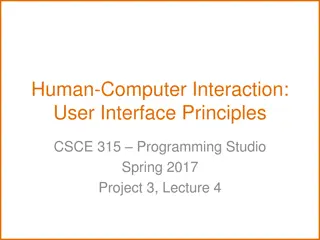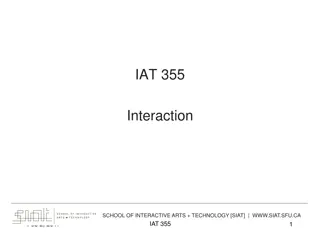Importance of Human-Computer Interaction (HCI) in User Interface Design
Human-Computer Interaction (HCI) is a crucial discipline focusing on creating interactive computing systems that are user-friendly and efficient. This involves designing, evaluating, and implementing systems that cater to users' needs, ultimately improving user satisfaction and productivity. The field aims to bridge the gap between users and computers, making technology more accessible and intuitive. HCI plays a significant role in enhancing competitiveness, reducing costs, and optimizing resource allocation by prioritizing user-centered design principles.
Download Presentation

Please find below an Image/Link to download the presentation.
The content on the website is provided AS IS for your information and personal use only. It may not be sold, licensed, or shared on other websites without obtaining consent from the author. Download presentation by click this link. If you encounter any issues during the download, it is possible that the publisher has removed the file from their server.
E N D
Presentation Transcript
HUMAN COMPUTER INTERACTION B.TECH III YR II SEMESTER(TERM 08-09) UNIT 1 PPT SLIDES TEXT BOOKS: The essential guide to user interface design, Wilbert O Galitz, Wiley DreamaTech. Designing the user interface. 3rd Edition Ben Shneidermann , Pearson Education Asia. No. of slides: 34
INDEX UNIT 1 PPT SLIDES S.NO. TOPIC LECTURE NO. PPTSLIDES 1 Introduction Importance of user Interface 2 Importance of good design 3 Benefits of good design 4 History of Screen design 5 REVISION L1 L1.1TO L1.8 L2 L2.1 TO L2.4 L3 L3.1 TO L3.8 L4 L5 L4.1 TO L4.10
Humancomputer interaction (HCI), alternatively man machine interaction (MMI) or computer human interaction (CHI) is the study of interaction between people (users) and computers. lecture 1 slide 1
With today's technology and tools, and our motivation to create really effective and usable interfaces and screens, why do we continue to produce systems that are inefficient and confusing or, at worst, just plain unusable? Is it because: 1. We don't care? 2. We don't possess common sense? 3. We don't have the time? 4. We still don't know what really makes good design? lecture 1 slide 2
Definition "Human-computer interaction is a discipline concerned with the design, evaluation and implementation of interactive computing systems for human use and with the study of major phenomena surrounding them." lecture 1 slide 3
Goals A basic goal of HCI is to improve the interactions between users and computers by making computers more usable and receptive to the user's needs. A long term goal of HCI is to design systems that minimize the barrier between the human's cognitive model of what they want to accomplish and the computer's understanding of the user's task lecture 1 slide 4
Why is HCI important? User-centered design is getting a crucial role! It is getting more important today to increase competitiveness via HCI studies (Norman, 1990) High-cost e-transformation investments Users lose time with badly designed products and services Users even give up using bad interface Ineffective allocation of resources lecture 1 slide 5
Defining the User Interface User interface, design is a subset of a field of study called human-computer interaction (HCI). Human-computer interaction is the study, planning, and design of how people and computers work together so that a person's needs are satisfied in the most effective way. HCI designers must consider a variety of factors: what people want and expect, physical limitations and abilities people possess, how information processing systems work, what people find enjoyable and attractive. Technical characteristics and limitations of the computer hardware and software must also be considered. lecture 1 slide 6
The user interface is t the part of a computer and its software that people can see, hear, touch, talk to, or otherwise understand or direct. The user interface has essentially two components: input and output. Input is how a person communicates his / her needs to the computer. Some common input components are the keyboard, mouse, trackball, one's finger, and one's voice. Output is how the computer conveys the results of its computations and requirements to the user. Today, the most common computer output mechanism is the display screen, followed by mechanisms that take advantage of a person's auditory capabilities: voice and sound. lecture 1 slide 7
The use of the human senses of smell and touch output in interface design still remain largely unexplored. Proper interface design will provide a mix of well-designed input and output mechanisms that satisfy the user's needs, capabilities, and limitations in the most effective way possible. The best interface is one that it not noticed, one that permits the user to focus on the information and task at hand, not the mechanisms used to present the information and perform the task. lecture 1 slide 8 back
The Importance of Good Design With today's technology and tools, and our motivation to create really effective and usable interfaces and screens, why do we continue to produce systems that are inefficient and confusing or, at worst, just plain unusable? Is it because: We don't care? We don't possess common sense? We don't have the time? We still don't know what really makes good design? lecture 2 slide 1
But we never seem to have time to find out what makes good design, nor to properly apply it. After all, many of us have other things to do in addition to designing interfaces and screens. So we take our best shot given the workload and time constraints imposed upon us. The result, too often, is woefully inadequate. Interface and screen design were really a matter of com- mon sense, we developers would have been producing almost identical screens for representing the real world. lecture 2 slide 2
Example bad designs Closed door with complete wood suggestion : glass door lecture 2 slide 3
The Importance of the User Interface A well-designed interface and screen is terribly important to our users. It is their window to view the capabilities of the system. It is also the vehicle through which many critical tasks are presented. These tasks often have a direct impact on an organization's relations with its customers, and its profitability. A screen's layout and appearance affect a person in a variety of ways. If they are confusing and inefficient, people will have greater difficulty in doing their jobs and will make more mistakes. Poor design may even chase some people away from a system permanently. It can also lead to aggravation, frustration, and increased stress. back lecture 2 slide 4
The Benefits of Good Design Poor clarity forced screen users to spend one extra second per screen. Almost one additional year would be required to process all screens. Twenty extra seconds in screen usage time adds an additional 14 person years. The benefits of a well designed screen have also been under experimental scrutiny for many years. One researcher, for example, attempted to improve screen clarity and readability by making screens less crowded. Separate items, which had been combined on the same display line to conserve space, were placed on separate lines instead. The result screen users were about 20 percent more productive with the less crowded version. lecture 3 slide 1
Proper formatting of information on screens does have a significant positive effect on performance. In recent years, the productivity benefits of well-designed Web pages have also been scrutinized. Training costs are lowered because training time is reduced support line costs are lowered because fewer assist calls are necessary. employee satisfaction is increased because aggravation and frustration are reduced. Ultimately, that an organization's customers benefit because of the improved service they receive. lecture 3 slide 2
Identifying and resolving problems during the design and development process also has significant economic benefits How many screens are used each day in our technological world? How many screens are used each day in your organization? Thousands? Millions? Imagine the possible savings. Proper screen design might also, of course, lower the costs of replacing "broken" PCs. lecture 3 slide 3
A Brief History of the Human-Computer Interface The need for people to communicate with each other has existed since we first walked upon this planet. The lowest and most common level of communication modes we share are movements and gestures. Movements and gestures are language independent, that is, they permit people who do not speak the same language to deal with one another. The next higher level, in terms of universality and complexity, is spoken language. Most people can speak one language, some two or more. A spoken language is a very efficient mode of communication if both parties to the communication understand it. lecture 3 slide 4
At the third and highest level of complexity is written language. While most people speak, not all can write. But for those who can, writing is still nowhere near as efficient a means .of communication as speaking. In modem times, we have the typewriter, another step upward in communication complexity. Significantly fewer people type than write. (While a practiced typist can find typing faster and more efficient than handwriting, the unskilled may not find this the case.) Spoken language, however, is still more efficient than typing, regardless' of typing skill level. lecture 3 slide 5
Through its first few decades, a computer's ability to deal with human communication was inversely related to what was easy for people to do. The computer demanded rigid, typed input through a keyboard; people responded slowly using this device and with varying degrees of skill. The human-computer dialog reflected the computer's preferences, consisting of one style or a combination of styles using keyboards, commonly referred to as Command Language, Question and Answer, Menu selection, Function Key Selection, and Form Fill-In. lecture 3 slide 6
Throughout the computer's history, designers have been developing, with varying degrees of success, other human-computer interaction methods that utilize more general, widespread, and easier-to-Iearn capabilities: voice and handwriting. Systems that recognize human speech and handwriting now exist, although they still lack the universality and richness of typed input. lecture 3 slide 7
Introduction of the Graphical User Interface The Xerox systems, Altus and STAR, introduced the mouse and pointing and selecting as the primary human-computer communication method. The user simply pointed at the screen, using the mouse as an intermediary. These systems also introduced the graphical user interface as we know it a new concept was born, revolutionizing the human-computer interface. back lecture 3 slide 8
A Brief History of Screen Design While developers have been designing screens since a cathode ray tube display was first attached to a computer, more widespread interest in the application of good design principles to screens did not begin to emerge until the early 1970s, when IBM introduced its 3270 cathode ray tube text-based terminal. A 1970s screen often resembled the one pictured in Figure 1.1. It usually consisted of many fields (more than are illustrated here) with very cryptic and often unintelligible captions. lecture 4 slide 1
Chronological History of GUI 1973 Pioneered at the Xerox Palo Alto Research Center First to put together all the elements of the modern GUI. 1981 First commercial marketing as the Xerox STAR. Widely introduced pointing, selection and mouse. 1983 Apple introduces the Lisa. Features pull-down menus and menu bars. 1984 Apple introduces the Macintosh. Macintosh is the first successful mass-marketed system. 1985 Microsoft Windows 1.0 released. 1987 - X Window System becomes widely available. 1988 NeXT s NeXTStep released. 1989 UNIX based GUIs released / Microsoft windows 3.0 released. 1992 OS/2 Workplace Shell released / Microsoft Windows 3.1 released. 1993 Microsoft Window NT released. 1995 Microsoft Windows 95 released.
Chronological History of GUI 1996 IBM releases OS/2 Warp4. Microsoft introduces NT 4.0 1997 Apple releases the Mac OS 8. 1998 Microsoft introduces Windows 98. 1999 Apple releases Mac OS X Server. A UNIX based OS. 2000 Microsoft Windows 2000 released. Microsoft Windows ME released. 2001 Microsoft Windows XP released. ASSIGNMENT - 2002 TO 2010
The Blossoming of the World Wide Web 1945 Hypertext concept presented by Vannear Bush. 1960 J. C. R. Licklider of MIT proposes a global network of computers. 1962 Design and development begins on network called ARPANET. 1969 ARPANET is brought online. Connects computers at 4 major universities. Additional universities and research institutions soon added to the network. 1973 ARPANET goes international. 1974 Bolt, Beranek and Newman releases Telenet. The first commercial version of ARPANET. 1976 University of Vermont s PROMIS released. The first hypertext system released to the user community. 1982 The term internet is coined. 1983 TCP / IP architecture now universally adopted. 1988 Apple s HyperCard released. Presents the hypertext idea to a wider audience.
The Blossoming of the World Wide Web 1989 Tim Berners-Lee and others at the European Laboratory for Particle Physics( CERN ) propose a new protocol for distributing information. Based upon hypertext. 1990 HTML created. In conjunction with Berners Lees protocol. ARPANET is decommissioned. 1991- HTML code released on the Internet by Tim Berners- Lee 1992 Delphi released. - First to provide commercial online internet access to subscribers. - Mosaic created by the National Center for Supercomputing Applications (NCSA) at the university of illionis - The first popular graphic-based hypertext browser. 1994 Netscape navigator version 1.0 released. World Wide Web Consortium founded. - To promote and develop web standards.
The Blossoming of the World Wide Web 1995 Microsoft IE versions 1.0 amd 2.0 released. - AOL , CompuServe, Prodigy, Yahoo and Lycos come online. - NSF ends internet support. -
A Brief History of Screen Design It was visually cluttered, and often possessed a command field that challenged the user to remember what had to be keyed into it. Ambiguous messages often required referral to a manual to interpret. Effectively using this kind of screen required a great deal of practice and patience. Most early screens were monochromatic, typically presenting green text on black backgrounds. lecture 4 slide 2
TDX95210 THE CAR RENTAL COMPANY 10/11/16 10:25 _________________ ______________________ ____________________ NAME TEL RO PUD RD C RT MPD ___________ ________ _________ _________ __________ ENTRY ERROR XX465628996Q.997 COMMAND Figure 1.1 A 1970s screen. lecture 4 slide 3
At the turn of the decade guidelines for text-based screen design were finally made widely available and many screens began to take on a much less cluttered look through concepts such as grouping and alignment of elements, as illustrated in Figure 1.2. User memory was supported by providing clear and meaningful field captions and by listing commands on the screen, and enabling them to be applied, through function keys. Messages also became clearer. lecture 4 slide 4
These screens were not entirely clutter-free, however. Instructions and reminders to the user had to be inscribed on the screen in the form of prompts or completion aids such as the codes PR and Sc. Not all 1980s screens looked like this, however. In the 1980s, 1970s-type screens were still being designed, and many still reside in systems today. lecture 4 slide 5
THE CAR RENTAL COMPANY RENTER LOCATION AUTOMOBIL The maximum allowed miles per day is 150. Enter Fl-Help F3-Exit F12=Cancel Name: _______________________ Telephone: ___________________ Office: _______________________ Pick-up Date:__________________ Return Date: __________________ Class: ______(PR. ST. FU. MD. CO. SC) Rate: _____________________________ Miles per Day:______________________ Figure 1.2 A 1980s screen. lecture 4 slide 6
The advent of graphics yielded another milestone in the evolution of screen design, as illustrated in Figure 1.3. While some basic "design principles did not change, groupings and alignment, for example, borders were made available to visually enhance groupings, and buttons and menus for implementing commands replaced function keys. lecture 4 slide 7
Multiple properties of elements were also provided, including many different font sizes and styles, line thicknesses, and colors. The entry field was supplemented by a multitude of other kinds of controls, including list boxes, drop-down combination boxes, spin boxes, and so forth. These new controls were much more effective in sup- porting a person's memory, now simply allowing for selection from a list instead of requiring a remembered key entry. lecture 4 slide 9
Completion aids disappeared from screens, replaced by one of the new listing controls. Screens could also be simplified, the much more powerful computers being able to quickly present a new screen. In the 1990s, our knowledge concerning what makes effective screen design continued to expand. Coupled with ever-improving technology, the result was even greater improvements in the user-computer screen interface as the new century dawned. lecture 4 slide 10























